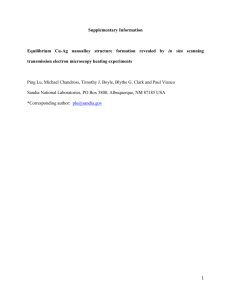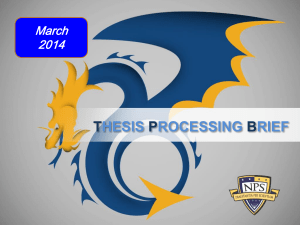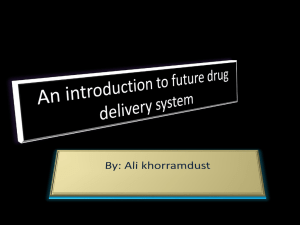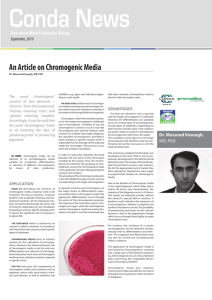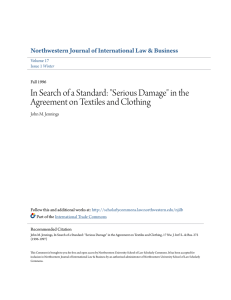Biofunctional Nanomaterials, CIC biomaGUNE, Parque tecnológico
advertisement
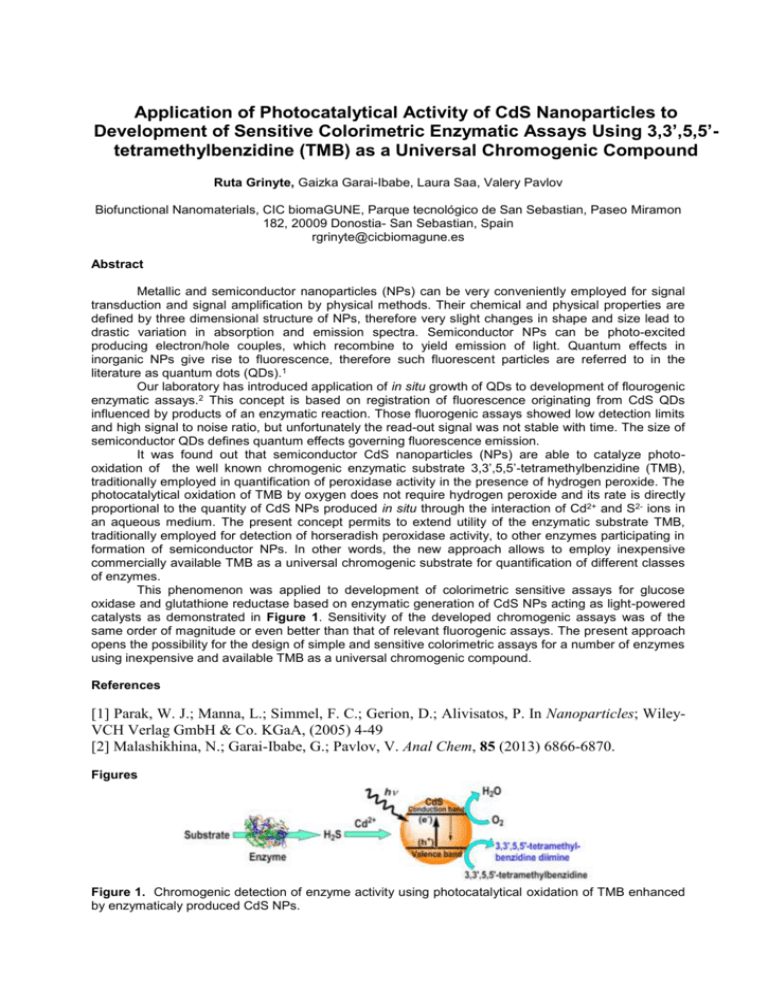
Application of Photocatalytical Activity of CdS Nanoparticles to Development of Sensitive Colorimetric Enzymatic Assays Using 3,3’,5,5’tetramethylbenzidine (TMB) as a Universal Chromogenic Compound Ruta Grinyte, Gaizka Garai-Ibabe, Laura Saa, Valery Pavlov Biofunctional Nanomaterials, CIC biomaGUNE, Parque tecnológico de San Sebastian, Paseo Miramon 182, 20009 Donostia- San Sebastian, Spain rgrinyte@cicbiomagune.es Abstract Metallic and semiconductor nanoparticles (NPs) can be very conveniently employed for signal transduction and signal amplification by physical methods. Their chemical and physical properties are defined by three dimensional structure of NPs, therefore very slight changes in shape and size lead to drastic variation in absorption and emission spectra. Semiconductor NPs can be photo-excited producing electron/hole couples, which recombine to yield emission of light. Quantum effects in inorganic NPs give rise to fluorescence, therefore such fluorescent particles are referred to in the literature as quantum dots (QDs).1 Our laboratory has introduced application of in situ growth of QDs to development of flourogenic enzymatic assays.2 This concept is based on registration of fluorescence originating from CdS QDs influenced by products of an enzymatic reaction. Those fluorogenic assays showed low detection limits and high signal to noise ratio, but unfortunately the read-out signal was not stable with time. The size of semiconductor QDs defines quantum effects governing fluorescence emission. It was found out that semiconductor CdS nanoparticles (NPs) are able to catalyze photooxidation of the well known chromogenic enzymatic substrate 3,3’,5,5’-tetramethylbenzidine (TMB), traditionally employed in quantification of peroxidase activity in the presence of hydrogen peroxide. The photocatalytical oxidation of TMB by oxygen does not require hydrogen peroxide and its rate is directly proportional to the quantity of CdS NPs produced in situ through the interaction of Cd2+ and S2- ions in an aqueous medium. The present concept permits to extend utility of the enzymatic substrate TMB, traditionally employed for detection of horseradish peroxidase activity, to other enzymes participating in formation of semiconductor NPs. In other words, the new approach allows to employ inexpensive commercially available TMB as a universal chromogenic substrate for quantification of different classes of enzymes. This phenomenon was applied to development of colorimetric sensitive assays for glucose oxidase and glutathione reductase based on enzymatic generation of CdS NPs acting as light-powered catalysts as demonstrated in Figure 1. Sensitivity of the developed chromogenic assays was of the same order of magnitude or even better than that of relevant fluorogenic assays. The present approach opens the possibility for the design of simple and sensitive colorimetric assays for a number of enzymes using inexpensive and available TMB as a universal chromogenic compound. References [1] Parak, W. J.; Manna, L.; Simmel, F. C.; Gerion, D.; Alivisatos, P. In Nanoparticles; WileyVCH Verlag GmbH & Co. KGaA, (2005) 4-49 [2] Malashikhina, N.; Garai-Ibabe, G.; Pavlov, V. Anal Chem, 85 (2013) 6866-6870. Figures Figure 1. Chromogenic detection of enzyme activity using photocatalytical oxidation of TMB enhanced by enzymaticaly produced CdS NPs.

